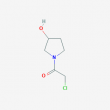
2-chloro-1-(3-hydroxypyrrolidin-1-yl)ethan-1-one - 1g
Short description
2-chloro-1-(3-hydroxypyrrolidin-1-yl)ethan-1-one: A Versatile Pyrrolidine Compound
Discover the exceptional 2-chloro-1-(3-hydroxypyrrolidin-1-yl)ethan-1-one, a high-quality pyrrolidine compound with a unique molecular structure and a CAS number of 1344314-23-3. This versatile chemical boasts a molecular weight of 163.60g/mol, offering a powerful tool for your advanced research and synthesis needs. Classified as a pyrrolidine and impurity, it exhibits a range of beneficial properties, including potential applications in pharmaceuticals and agrochemicals. However, handle with care as it is known to cause skin and eye irritation, as well as respiratory discomfort. Always store in a cool, well-ventilated area and wear appropriate personal protective equipment when working with this compound. Unlock the potential of this exceptional pyrrolidine in your next groundbreaking project.
- CAS: 1344314-23-3
- Molecular Weight: 163.60g/mol
- Hazard Statements: H302, H315, H319, H335
- Precautionary Statements: P261, P264, P270, P271, P280, P301+P330+P331, P303+P361+P353, P304+P340, P305+P351+P338, P308+P313, P321, P362+P364, P403+P233, P405, P501
-
Procurenet Team Tshim Sha Tsui
Hong Kong 3 years
Description
2-chloro-1-(3-hydroxypyrrolidin-1-yl)ethan-1-one
Unlock the versatile potential of 2-chloro-1-(3-hydroxypyrrolidin-1-yl)ethan-1-one, a highly specialized chemical compound that holds the key to unlocking new frontiers in scientific research and development. With its unique chemical structure and exceptional purity, this Pyrrolidine and Impurities derivative is a valuable asset for researchers and scientists across various disciplines.
Boasting a CAS number of 1344314-23-3 and an InChIKey of OGWOVTRJCWWTOT-UHFFFAOYNA-N, this compound presents a molecular weight of 163.60000610351562, offering a distinct chemical profile that can be leveraged in a wide range of applications. Whether you're exploring the realms of pharmaceutical development, agrochemical innovation, or material science, 2-chloro-1-(3-hydroxypyrrolidin-1-yl)ethan-1-one is a versatile tool that can help you unlock new possibilities.
Pharmaceutical Research
In the dynamic world of pharmaceutical research, 2-chloro-1-(3-hydroxypyrrolidin-1-yl)ethan-1-one shines as a crucial building block in the synthesis of innovative drug candidates. Its unique chemical structure and properties allow researchers to explore new therapeutic avenues, targeting a spectrum of health conditions and disorders. By harnessing the potential of this compound, scientists can develop novel pharmaceuticals with enhanced efficacy, selectivity, and safety profiles, ultimately improving patient outcomes.
Agrochemical Innovation
The agricultural industry also benefits from the versatility of 2-chloro-1-(3-hydroxypyrrolidin-1-yl)ethan-1-one. This compound serves as a valuable starting material in the development of advanced crop protection agents, such as pesticides and herbicides. Its distinct molecular structure contributes to the creation of more potent and selective agrochemicals, helping to safeguard crops, increase yields, and minimize environmental impact.
Material Science Advancements
Beyond the realms of pharmaceuticals and agrochemicals, 2-chloro-1-(3-hydroxypyrrolidin-1-yl)ethan-1-one finds its place in the exciting world of material science. Researchers in this field leverage the unique properties of this compound to engineer novel materials with enhanced performance characteristics. Whether it's improving mechanical strength, thermal stability, or optical properties, the integration of 2-chloro-1-(3-hydroxypyrrolidin-1-yl)ethan-1-one can lead to the development of cutting-edge materials with far-reaching applications.
Safety and Handling
While 2-chloro-1-(3-hydroxypyrrolidin-1-yl)ethan-1-one is a powerful tool in the hands of researchers, it is essential to handle it with care and adhere to strict safety protocols. This compound is classified under hazard class 14.1.5, with a range of hazard statements (H302, H315, H319, H335) and precautionary statements (P261, P264, P270, P271, P280, and more) that must be observed. Proper personal protective equipment, such as gloves, clothing, eye protection, and respiratory protection, is crucial when working with this substance. Additionally, it is important to store 2-chloro-1-(3-hydroxypyrrolidin-1-yl)ethan-1-one in a well-ventilated area and keep the container tightly closed to maintain its stability and integrity.
Further Resources
To delve deeper into the technical details, applications, and safety guidelines of 2-chloro-1-(3-hydroxypyrrolidin-1-yl)ethan-1-one, consult the comprehensive product information available through the Ref # 10-F245520. This resource provides a wealth of data, including the compound's chemical properties, handling instructions, and potential use cases, empowering you
Specifications
- Class: 14.1.5
- H statements: H302:Harmful if swallowed.H315:Causes skin irritation.H319:Causes serious eye irritation.H335:May cause respiratory irritation.
- Inchi key: InChIKey=OGWOVTRJCWWTOT-UHFFFAOYNA-N
- Molecular weight: 163.60000610351562
- Notes: This product is intended for laboratory use only, and it is not meant for human consumption.Signal word: Warning
- P statements: P261:Avoid breathing dust, fumes, gas, mist, vapours, spray. [As modified by IV ATP].P264:Wash thoroughly after handling.P270:Do not eat, drink or smoke when using this product.P271:Use only outdoors or in a well-ventilated area.P280:Wear protective glove





